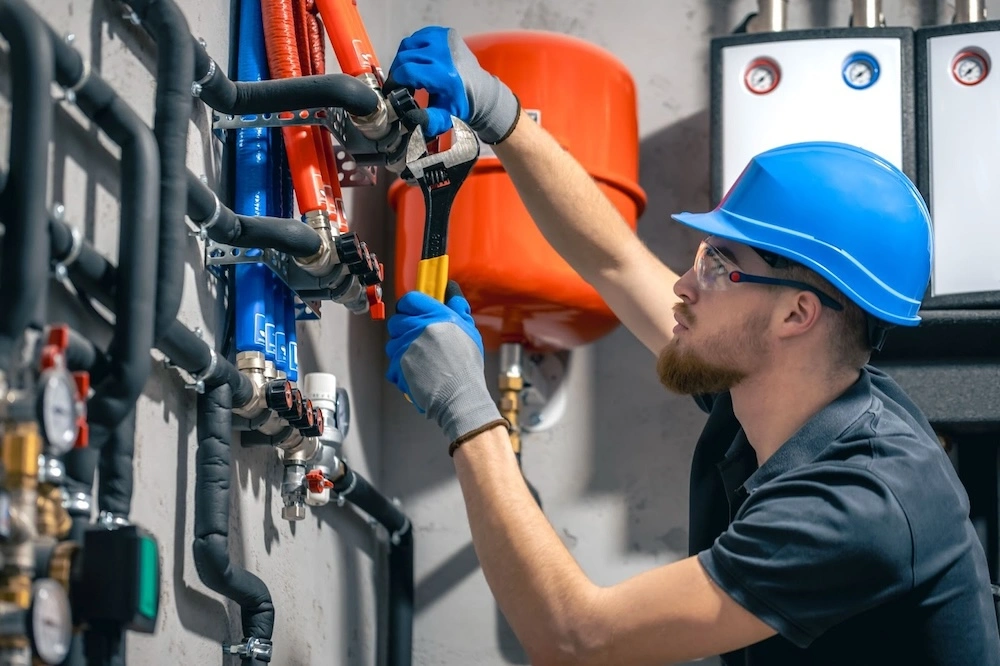6 Promising Career Paths for Pipefitters
Here are 6 in-demand fields that value your foundation of technical, safety, and problem-solving skills.
1. Industrial Maintenance Technician
Industrial maintenance technicians are responsible for keeping the machinery and equipment in factories, warehouses, and power plants running.
The job often involves diagnosing mechanical faults, replacing worn components, and calibrating control systems.
How Your Skills Transfer
If you're already used to troubleshooting pressure systems, interpreting technical drawings, and working in plant environments, transitioning into industrial maintenance is a natural next step.
Your pipefitting background gives you an edge in interpreting schematics, understanding pressurized systems, and working safely around industrial equipment.
It’s a good fit for pipefitters with experience in plant maintenance, machine repair, or automated systems.
Key Differences from Pipefitting
Unlike pipefitting, this role leans more into mechanical and electrical diagnostics, working with programmable logic controllers (PLCs), motors, pumps, and automation systems.
Many former pipefitters find the shift appealing because the environment is more predictable — often indoors with regular hours — and there's less physical strain than field installation or repair work.
Market Outlook & Compensation
The median salary for industrial machinery mechanics and maintenance technicians in the U.S. is $63,510. These jobs are expected to grow by 15% through 2033, which is much faster than average.
Competitive Advantages
Employers value pipefitting experience, especially in high-stakes environments like food processing, automotive manufacturing, and logistics centers.
If you already have welding, HVAC, or plumbing experience alongside pipefitting, you're even more competitive. Employers increasingly look for multi-skilled technicians who can do repairs and preventive work with minimal supervision.
Training Requirements
Short-term certificate or associate program in mechatronics, electrical systems, or mechanical maintenance. You can complete training in under a year through the Mechatronics Pathway on Unmudl.

2. Construction Project Manager
Project managers (PMs) oversee construction timelines, budgets, teams, safety compliance, and communication between stakeholders. It allows you to enjoy the best of construction while moving beyond the physical demands of trade work.
How Your Skills Transfer
You won't be starting from scratch, as many of the skills you've already developed translate directly into PM duties. These include reading blueprints, managing subcontractors, estimating material needs, and resolving site issues.
It’s a great role for experienced pipefitters and steamfitters with leadership instincts, fluency with blueprints, and an interest in managing field teams.
Key Differences from Pipefitting
Unlike tradeswork, these roles involve more planning and paperwork, but you'll still walk job sites and stay connected to field operations. It's ideal for tradespeople who want to lead projects without giving up their connection to the work itself.
Market Outlook & Compensation
Construction project managers make $96,908 a year, on average. Project management jobs are expected to grow in line with the construction industry overall, which is set to expand by a healthy CAGR of 5.5% till 2029.
Competitive Advantages
Some companies promote senior crew members into PM roles informally, but on-site experience goes a long way, and formal training can fast-track your advancement.
Your hands-on experience gives you credibility with field teams and helps you spot potential issues before they become costly problems.
Training Requirements
Certificate programs are widely available, including programs specifically in construction management offered by organizations such as the American Institute of Constructors.
Usually, part-time training or a construction management certificate takes 6 to 12 months.
Look for programs that cover scheduling software (like Procore or Primavera), contracts, and OSHA safety standards.
3. Building Automation Systems Technician
Building Automation Systems (BAS) Technicians install and maintain the networks that control heating, cooling, ventilation, lighting, and security.
It's a hybrid job requiring mechanical understanding, electrical systems familiarity, and basic programming or networking skills.
How Your Skills Transfer
If you've worked with HVAC piping, control valves, or systems integration on commercial jobs, you've already touched the world of building automation.
For pipefitters and steamfitters used to managing flow, pressure, and system behavior, this kind of work is more aligned than it might seem.
Key Differences from Pipefitting
There's growing overlap between BAS and HVAC roles, especially in large facilities like hospitals, data centers, and universities.
The work involves more digital interfaces and programming compared to traditional pipefitting, but the fundamental understanding of systems remains crucial.
Market Outlook & Compensation
Driven by increasing demand for energy efficiency and smart building tech, BAS is a rapidly growing, well-paying industry.
The global industry is projected to have a CAGR of 10% till 2030, with North America projected to remain the fastest-growing market. In the U.S., the average salary for Building Automation Technicians is $74,773 per year.
Competitive Advantages
If you're already familiar with commercial control systems or have worked with building engineers, you're ahead of the curve. Mechatronics concepts — like feedback loops and system diagnostics — are especially useful here and are covered in many modern BAS courses.
Training Requirements
6 to 9 months of specialized BAS or controls systems training. Training programs cover topics like sensors, controllers, networking, and digital interfaces.
Mechanical system experience and basic electrical literacy are a huge plus.

























.webp)